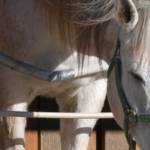Measuring Body Temperature in Horses

A rise in body temperature is a natural way for horses to fight off disease and is often the first sign of a health problem. As a treatment tool, veterinarians track fever to assess treatment efficiency. In both private barns and hospital settings, however, recording of rectal temperatures is oftentimes unreliable. Because of this, researchers have found a way to accurately and consistently record body temperature that hinges on modern technology.
To gather body temperature, researchers used a disposable sensor, affixed to the underside of the tail, to read body temperature data and send it via Bluetooth to a tablet computer. This is a technique similar to axillary, or armpit, temperature measurement in humans. With the concept in place, researchers pinpointed a group of horses in which fever was expected, in this case immediately following routine vaccination for influenza.
Nineteen Thoroughbreds were fitted with body-temperature sensors immediately before vaccination, and the sensors were kept in place for 32 hours. In addition, rectal temperatures were taken prior to vaccination, eight hours after vaccination, and 22 hours after vaccination. Researchers compared the two sets of values.
The sensor stayed in place on 16 of the horses, so temperature data from those horses were used in the final statistical analysis. Nine horses developed fever 10-21 hours following influenza vaccination. While the sensors recorded lower temperatures than rectal temperature measurements, sensors detected all cases of fever. Of importance, the sensors detected fever overnight, when rectal temperatures were not taken.
In sum, the researchers concluded that “the sensors represent a reliable alternative method of monitoring the temperature of horses. The technique of continuous remote measurement significantly improves the current best practices advised for manual rectal-monitoring intervals commonly used in the industry.”
Fast facts about your horse’s body temperature:
- A body temperature at or below 101.5° F (38.6° C) in mature horses is considered normal. Foals, on the other hand, generally have a slightly higher normal temperature.
- Temperature readings above 101.5° F (38.6° C) may be problematic. While exercise can elevate a horse’s temperature, it should be back to normal within 90 minutes of finishing exercise. If the temperature remains above that threshold, the horse could be developing a health problem.
- Horses with anhidrosis may have trouble cooling and maintain a higher body temperature following exercise than other horses.
- All horses should be comfortable having their temperature taken. Before making a farm call, most veterinarians will ask for the horse’s temperature as a matter of course when discussing a problem such as colic or laminitis.
Fever frequently accompanies inappetence in horses. “When faced with a horse that refuses to eat, consider taking its temperature to be sure something more sinister than mere fussiness isn’t brewing,” advised Catherine Whitehouse, M.S., a nutrition advisor for Kentucky Equine Research. “A horse may back off its feed for many reasons, of course, but if the horse normally eats with gusto and suddenly refuses its feed, then it’s time to look more closely for a cause. Getting a body temperature is a quick way to determine if the horse is fighting off an internal problem.”
*O’Donnell, M., and S. Rosanowski. 2020. Detection of pyrexia in horses using novel temperature sensor. The Equine Veterinary Practitioner 44(4):37-38.








